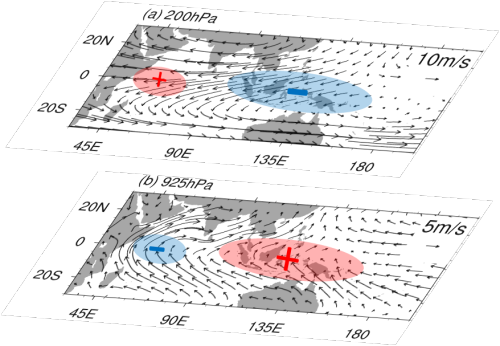Scientists Find a Seesaw Pattern between Upper- and Lower-Level Cross-equatorial Flows
Date:2020-02-17
A strong seesaw pattern exists between the interannual variability of upper- and lower-level cross-equatorial flows (CEFs) over the Maritime Continent and Indian Ocean in boreal summer, according to a recently published study in Advances in Atmospheric Sciences by PhD candidate ZHAO Xiaoxuan and Prof. LU Riyu, from the Institute of Atmospheric Physics, Chinese Academy of Sciences.
CEF, as the name suggests, refers to the airflow across the equator. During boreal summer in the Eastern Hemisphere, southerlies prevail in the lower troposphere, characterized by several branches, while well-organized northerlies prevail in the upper troposphere. This characteristic of CEFs determines its important position in the interhemispheric exchange of mass and energy. Meanwhile, CEFs play a crucial role in modulating monsoon rainfall. Besides, the CEF over the Maritime Continent is also regarded as a significant factor contributing to the climate variability in the western North Pacific and East Asia.
"In previous studies, compared with the wide attention paid to the lower-level CEFs, the upper-level CEFs, especially their variability, have basically been ignored," says LU, the corresponding author of this study. "Integrated analyses of both the lower- and upper-level CEFs are necessary and should prove helpful for a better understanding of CEF variability, particularly if there is a close relationship between the lower- and upper-level CEFs."

There is a seesaw relationship between upper- and lower-level cross-equatorial flows over the Maritime Continent and Indian Ocean on the interannual time scale. Vectors represent the climatological winds. (Image by ZHAO Xiaoxuan)
ZHAO and LU evaluated the vertical structure of the variability in CEFs over the Maritime Continent and Indian Ocean during boreal summer, based on three reanalysis datasets: ERA-Interim, JRA-55, and NCEP-2. The results show that there is a high consistency in the interannual variability of CEFs among the three datasets, especially between ERA-Interim and JRA-55, while great uncertainly exists in the decadal or long-term changes of CEFs. Further analyses on the interannual variability in CEFs indicate that there is a significant negative relationship between the upper- and lower-level CEFs over the Maritime Continent; that is, the northerlies at the upper level and southerlies at the lower level are both enhanced or weakened. This seesaw pattern is also significantly related to the CEFs over the Indian Ocean. This close relationship between upper- and lower-level CEFs and between the Maritime Continent and Indian Ocean is manifested as the leading mode of equatorial meridional winds in the vertical-zonal section over the Maritime Continent and Indian Ocean, and can be mainly explained by ENSO.
"This study provides a supplement to existing understanding from the perspective of the vertical structure of CEFs," says LU. "We do not discuss in depth the possible mechanism and physical processes for the formation of this vertical structure, except a brief discussion on the contribution of ENSO, in this study. According to some other analyses, the relationship between ENSO and CEFs seems to be complicated, and thus this relationship, as well as other possible physical processes, deserve further research."
Reference
Zhao, X. X, and R. Y. Lu, 2020: Vertical structure of interannual variability in cross-equatorial flows over the Maritime Continent and Indian Ocean in boreal summer. Adv. Atmos. Sci., 37(2), https://doi.org/10.1007/s00376-019-9103-0.
Media contact: Ms. LIN Zheng, jennylin@mail.iap.ac.cn
